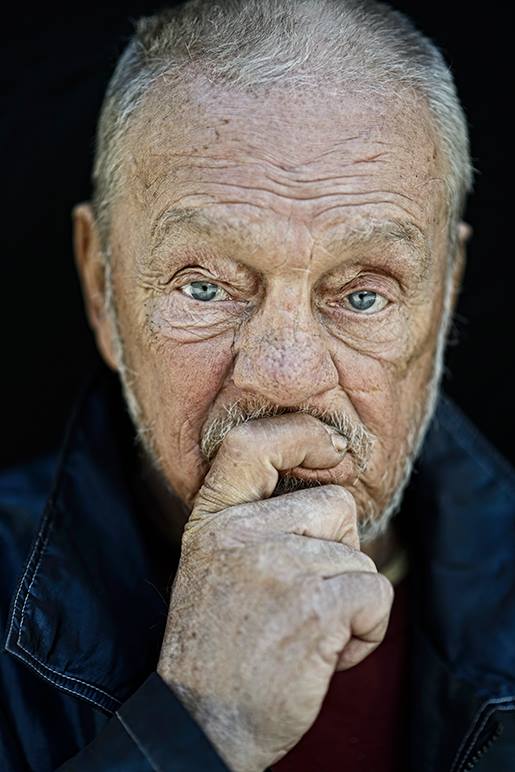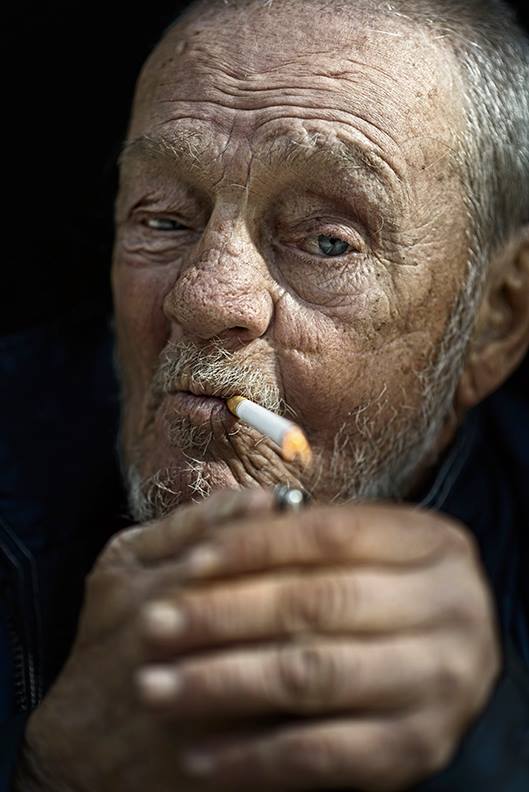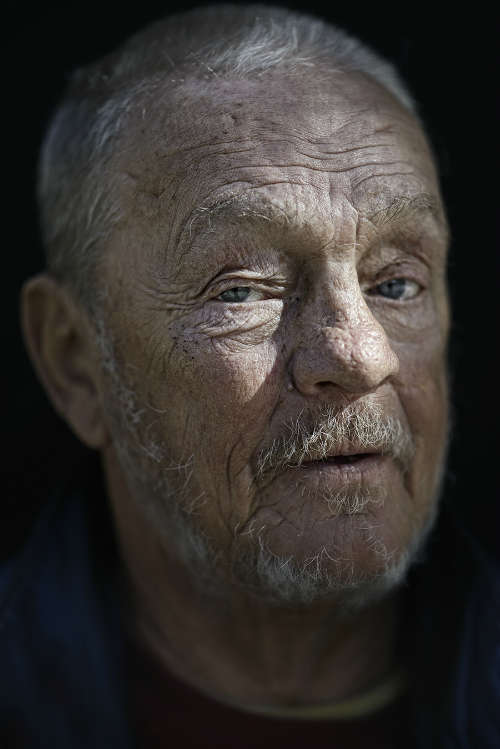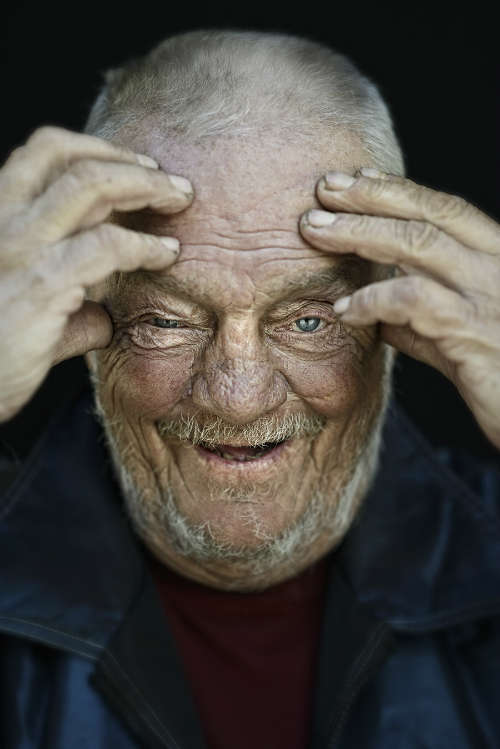MY FRIEND CHARLES, PART I, “YOU DIG”
It was a warm and brilliant spring morning, a cloudless blue sky and just a whisper of a breeze. I decided to go downtown and explore a new area of the city in which a homeless shelter was located. Little did I know the significance this shelter would have during the next three years of my photographic journey. At that time, taking images of homeless individuals was a relatively new project, and everyday brought new adventures and anticipation. I had so much to learn.
Although it was early morning, I had already taken several good images and was looking forward to a productive day. As I approached the corner, there he was, dressed in baggy pants and ball cap, a cigarette dangling from his mouth. Leaning nonchalantly against a lamppost, his mouth in a wry smile and eyes shining, he appeared as if he was in paradise with not a care in the world. His name is Charles.
I was just getting familiar with the homeless scene and was eager to engage in conversations and hear more about what was happening in the area. Charles and I connected that day, but I had no idea he would become a close friend and confidant. In our first meeting, I could sense he had a story I wanted to hear. Granted, many homeless folks have heartbreaking stories, as did Charles, but he also had a philosophy about life that captured my curiosity.
His small stature belied his inner intensity and the fervor that ran throughout his soul. He had the demeanor of a young person. I was amazed when he showed me his identification to prove he was 72 years of age. He blurted out in his deep southern drawl, “I’m 72, you dig.” “You dig,” was Charles’ favorite expression. Direct from New Orleans, he had been in San Diego for about six months. Nonetheless, it was not long before he took umbrage at the city’s treatment of the homeless population. He had passionate opinions about most everything, especially the homeless situation.
I will forever remember my first day with Charles. His subject du jour was God. Charles loved the Lord and enjoyed speaking about him. “Lord didn’t promise you a rose garden, just said he will take care of your wants and needs, you dig.” I listened intently and was engrossed in his dialogue as he pontificated about religion. After that day, I was already looking forward to meeting him again and learning more about his life.
In the months to come, Charles and I spent a great deal of meaningful time together. He liked to accompany me when I took photographs and always had my back. If he felt we were threatened, he would act like a bulldog and just get in your face. Amazingly, nothing appeared to frighten him, and I often wondered where he acquired his fearlessness. Eventually I would learn from whence his courage came.
Early in our friendship, Charles told me he chose to be homeless and did not have to live on the streets. This was unfathomable after everything I had witnessed in the previous months, the
illness, hunger, depression, and worst of all the homeless children. Why? As we shared our life experiences, Charles revealed his personal story and heartbreak.
MY FRIEND CHARLES, PART II, LOVE AND DEATH
 Many years ago Charles was contacted by someone who knew he had a construction background. This led to a contract assignment to build a bridge in Belize. It was there he met Kathy and fell in love. Charles spoke tenderly about love, especially his love for Kathy. “You know when you find love, it just flows, love is, you dig. You do anything for that person. Love is not easy to find but once you find it, you know. I found that only once in my life, with my wife, you dig.”
Many years ago Charles was contacted by someone who knew he had a construction background. This led to a contract assignment to build a bridge in Belize. It was there he met Kathy and fell in love. Charles spoke tenderly about love, especially his love for Kathy. “You know when you find love, it just flows, love is, you dig. You do anything for that person. Love is not easy to find but once you find it, you know. I found that only once in my life, with my wife, you dig.”
Kathy and Charles married, moved to New Orleans, and Charles opened a construction company, which eventually was very profitable and at one time had twenty-nine employees. Although there was about a 20-year difference in age, they were very devoted to each other. Unbeknownst to Charles, Kathy became pregnant. Although she was in her early fifties, she wanted them to have a child. She understood the dangers of pregnancy at her age but refused to dwell on them. She forbid the doctor to tell Charles about the baby until she had no choice. Charles learned about the baby when she was in her third trimester; he was overwrought with worry.
Kathy died while giving birth to a healthy boy, Sean Don. Charles was devastated and overcome with raging anger. Not knowing how to handle her death, and angry with the doctor, he took his gun, jumped into his Tahoe and drove to the hospital. As he pulled into the parking lot, he realized the implications of what he was about to do, he was also aware he could easily kill him. He sat in the car to pull himself together, and after he calmed down, he went home to grieve.
Kathy’s mother came from Belize to take care of the baby, but things were trying for Charles. Kathy was his first and only profound love, and life without her was unbearable. She was everywhere; the house and the baby were constant reminders. He felt a void within him and wanted to escape his misery. At 71 years old, Charles knew he did not have the stamina to properly care for his son. Therefore, he arranged with his mother-in-law to take the baby back to Belize. He sold his business, his seven-room house, two SUV’s, set up a trust fund so that the baby would “want for nothing.” He then headed to San Diego where the street became his home. We met about six months after his arrival.
Money was not a problem for Charles. I would learn later on that Charles received about $3,000 per month. Needing little for himself, he sent money to his son and gave what remained to other homeless people. On many occasions, I would try to convince him it was time to get a roof over his head. He was getting older, and the street takes its toll, both physically and emotionally. He always refused to leave the streets.
We spent hours at a time talking while I was photographing others. I often confided in him about my personal “stuff,” and he always listened and gave sage advice gleaned from his life experiences. He would speak about himself, but I felt something was missing; there was an invisible wall between us. I was patiently waiting for the rest of his story.
MY FRIEND CHARLES, PART III, THE LOBSTER CREATURES
Life goes on. I was busy and had not seen Charles in a few weeks. I headed downtown to take some images and decided to check on him. He was walking unusually slow. He ploddingly pushed his cart with Tiger, his small dog, trailing behind, and it was obvious something was wrong. He usually was full of energy. I told him he looked like hell. Charles and I were always upfront with each other. He told me his legs hurt and were very swollen. He felt awful. Thinking it may be his heart, I insisted we get to a hospital. I was about to break my number one rule: never let anyone in my car. But, he was my friend, I had no choice. Before we could leave, however, we had to take care of two small problems: the shopping cart and Tiger. Charles, of course, did not trust anyone. By now, I had many connections within the homeless community and put the word out that I was looking for a particular homeless young man, Chris. He was someone I could trust. Within ten minutes, Chris showed up, and we made the arrangements understanding Charles might be out of commission for a while.
With my help, Charles was seated in the car. Immediately, I was overwhelmed from the odor coming from his body. The horrid stench caused my eyes to begin watering profusely. In an effort to avoid a sudden collision, I gripped the steering wheel tighter. As I quickly glanced at Charles, with what vision I still had, his leg appeared to be moving, but yet his legs were still. At second glance, I noticed what looked like an army of tiny lobsters crawling on him. I silently freaked out, and with the smell and an army of tiny lobsters forging their attack, I drove aimlessly, hoping to discover the hospital. With every wrong street I turned down, the tiny lobsters got closer.
I came across a convenience store relieved I could finally get directions and put an end to this nightmare. I approached the cashier and pleaded for directions to the nearest hospital, but he just stared at me. He did not speak English. I realized I was on my own to find the hospital. After searching several more minutes, I saw my beacon of light: the hospital. However, I had no time to cry with joy.
We reached the emergency room, and I dropped him off to park the car. Frantically I parked the car in the hospital’s covered garage. My mind was racing with thoughts of Charles dying and the lobster creatures devouring my car. Alone at last with the lobster creatures, I was determined to kill them one by one with my bare fingers. They were embedding themselves in the car seats, in the rug, everywhere! The sweat from my hands and the strange design of their tiny bodies made every attempt to crush them ineffective. Maybe that was my payback for all the bugs I had stepped on or squashed in my lifetime. By then, I was overwhelmed with fear. I restorted to collecting a few as fast as possible and placed them in a zip lock bag. I was furious with myself for breaking my rule and with Charles for knowingly putting me in this situation.
I took the bag with me hoping someone would be able to identify these strange bugs. With a mixture of anxiety and frustration, I approached the hospital front desk, adamant on having a doctor examine these bugs. At first, the two receptionists showed no desire in helping me find a doctor for my bug problem. However, they had no idea how I had spent my last hour. I asked them again to see a doctor, this time with an authoritative tone. The doctor and I studied the tiny creatures; he cringed and said they were not ticks, but did not know what they were. I approached Charles, and in an irritated voice, I asked, “What’s wrong with you? How did you let yourself get this way with bugs all over you?” I was greeted with silence and then saw his tough guy demeanor fade away. I backed off and tended to what had to be done. With Charles’ consent, we put my name on his hospital file as the contact. It was his turn to enter the double doors to the emergency room, and his nervousness was apparent as he walked down the corridor, little lobster creatures still crawling on him. He preferred I not go in with him. He felt badly enough. “Charles, you’ll be okay,” I said, with as much confidence I could muster. I told him I would call him early evening.
I then jumped into my car with the blind hope that there would be no lobster creatures still slithering over the seats; but no such luck. Phase two of my enemies’ attack had been launched. They were there, alive and quickly conquering the interior of my car. I had little time to focus on them. I had to get home, but only had a vague idea of my location, let alone how I had arrived here. I started the car and exited onto the main street, only to find that the biggest marathon of the year was that day. I tried every on ramp within a five-mile radius; every one of them was blocked off. My anxiety had just reached a new level. I did not know whether to scream at the top of my lungs or throw a temper tantrum, so I settled on the awkward combination of both. At every stop light, I discovered a new person watching in horror at my psychotic behavior. I had a frustrated conversation with God; we had not communicated for quite some time.
After more than an hour of this ordeal, I arrived home. My work was not over, however. It was now time for me to strike back against my ubiquitous foe and annihilate these little lobster bastards. I unleashed my best bug killing bombs and, of course, Lysol. I figured Lysol kills everything; at least that is what the commercials say, right? I waited for the results like a hopeful, obsessive general. After hours of spraying, my strategy prevailed, and the bugs ceased to exist. It took weeks for me to feel comfortable in my own car. Every time I felt an itch or scratch, I felt their presence creeping and crawling towards me. Charles and I would end up laughing about that day.
Late in the evening, I spoke to the doctor and then called Charles. I could hear the cracking in his voice.
MY FRIEND CHARLES, PART IV, FACES OF THE FORGOTTEN
They did not have a diagnosis for Charles yet, and my fearless friend, was worried, very worried. I assured him I would be there for him and communicate with the doctors. When I hung the phone up, I felt his fear, his loneliness, and my eyes welled up.
For the first time, I realized I was not just photographing homeless individuals. Of course, I knew the people I was meeting were thinking and feeling human beings; but until now, the photographs were just images. As I thought about my photographic journey, I realized I was no longer taking pictures with the intention of getting a great image. I had a more purposeful and deeper mission, to permanently record all of these individuals in a book. That night led to the birth of Faces of the Forgotten. Some people meet for a reason. Charles opened my eyes to another way of looking at the homeless and how they live. I started to feel. I did not know at that time those feelings would also lead me to darker places.
MY FRIEND CHARLES, PART V, BEING EATEN ALIVE
Charles was in the hospital for a week. I visited him often to speak with the doctor and check he was receiving the medical attention and care he needed and deserved. He spent his time staring out the window watching people and cars as they passed below. He never watched TV. We would joke about his lavish private room, and even though he had a nice peaceful place to sleep, I could sense he was itching to get back on the streets.
Charles had a major infection in his legs acquired from the flesh eating bugs embedded in his skin and was being treated with strong antibiotics. These bugs were literally eating him alive. After a week they declared him “sanitized,” and they discharged him to the streets. Honestly, I was impressed with the hospital. They treated him with respect and made his stay comfortable. He left the hospital with a new set of clothes.
MY FRIEND CHARLES, PART VI, THE BIRDS
Charles recovered his strength and we continued our lunches. I was excited about Faces of the Forgotten and when I explained the book project, he loved the idea, being a big advocate of the homeless. Our friendship was growing and the emotional ties getting deeper. I remember a pivotal point in our relationship. It was an overcast misty day, and I was downtown on one of my photographic journeys. My mood was gloomy, and I felt depleted. I had walked a few miles and my energy just drained away. On my way to my car, I stopped to see Charles. He was lying on his sleeping bag with Tiger and a flock of pigeons surrounding him. Pigeons were everywhere. The ground was practically covered with pigeon droppings, but Charles seemed oblivious to it. He had his refuge from the cold. He must have sensed something was wrong with me because he asked, “What’s going on?” I was barely able to hear him through the mass of pigeons; not wanting to be rude, I took a seat next to him and his feathered companions. Bold move for me to rest my body and hands on bird dropping. “Too much stuff, you dig,” I answered. He would not let me leave until we talked through the issues. “Derek, a man is lucky to have two or three friends in his life, real friends, you dig,” he said, as he held up two fingers. “And you are one of those good friends, you dig. Life is a onetime thing; life is short.” He proceeded to tell me, “The Lord will never put more on your shoulders than you can handle, you dig.” I will never forget that moment. It was a real connection, beautifully juxtaposed to the pigeon droppings that were seeping through my clothes and staining my hands. As I think back, it must have been an odd scene.
We continued to speak about life, having faith, and how to survive. After a couple hours, I went on my way covered in pigeon droppings.
MY FRIEND CHARLES, PART VII, THE VIETNAM TRAP
Charles and I had developed a close friendship, and both valued the time we spent together. The stories he shared reflected a man capable of deep love and integrity, yet also a man who appeared to have a simmering anger just below the surface. As I noted earlier, there was more to Charles’ life, but I had yet to discover what.
I had already slept on the streets at different times and for a couple days at a time in different cities. But I wanted to experience what Charles did on a daily and nightly basis, so I planned to sleep on the street with him and get a sense of his reality. The streets change at night and interesting characters come out of the shadows. There were carts piled high with sundry items were lined up in a row near their owners. Honestly, it was hard to sleep with the god-awful stench of urine, rotten food, and giant cockroaches. I wondered how anyone could get a decent night’s sleep, but human beings seem to adapt.
It was about 1:30 am and things calmed down a bit. We lay there looking at a bright full moon and sparkling stars. I asked Charles, “Wouldn’t it be nice to have a roof over your head?” Staring at the sky, “It’s not such a bad roof now,” he answered. He told me he felt at home on the street and was comfortable sleeping outside. Things began to fall in place and something clicked. For several years we had talked and shared many stories, but it never dawned on me that Charles might be a Vietnam veteran. I asked, “Why didn’t you tell me you were in the Vietnam War?” “It never came up,” he said. “Some people talk about things and some don’t. The past is gone. If people could put the past behind, the world would be a lot better off, you dig.” He started to share some of his stories, and I was pleased but surprised he did not feel uncomfortable talking about his experiences.
Sometime in 1956, while living in New Orleans, Charles decided to enlist in the Marines. He was sent to San Diego for boot camp. Two months into his training, the military determined he had the skills to be an excellent marksman. Therefore, they sent him for special training at the Great Lakes Naval Center. After four months, he was transferred back to Camp Pendleton for an additional eight weeks of training. He then was appointed to the Special Forces.
Charles was recognized for his excellent marksmanship and singled out to go to Vietnam before the war started. His task was to train others to shoot skillfully in preparation for combat. This was the start of a difficult seventeen year military career.
He spoke with affection and deep concern about the new recruits who had not the slightest idea about life on the battlefield. “Those poor young lads were so green,” he lamented. He warned them about the dangers they would encounter. For example, the enemy would often lay a baby in the road rigged with explosives. However, it did not always stop a new recruit. Without thinking, some of the recruits would run to rescue the child and get blown up in front of his eyes. Charles developed a sense of self-preservation and was extremely cautious. He had seen too many soldiers get overly comfortable and relax their vigilance only to die under enemy fire.
“Vietnam was hell,” he said. “The jungle so thick you couldn’t see anything but the tree tops.” Because he had spent so much time there, he became accustomed to sleeping outside.
At one time, he led a platoon of approximately 125 soldiers. So many were killed in combat, that when he arrived back at base, only ten men were still alive. However, reinforcements were always sent and off he went to the next battle. He witnessed his men blown apart, body parts everywhere. Death was all around. Charles admitted he killed many enemies, but said he did what he had to do. Smoking weed was rampant, and the men at times would go a bit wild. Many scalped the enemy and made leather pouches to hold the marijuana. “It was crazy, you dig.”
Charles never thought he would get out alive. Many nights he just laid in bed thinking; haunted by the death of his fellow soldiers and tormented that he was still breathing. He admitted his faith in God, even then, was strong. “It wasn’t my time, you dig.” It was from this time forward, his life and personality started to change.
He said he had no regrets and held no grudges. “I love this country” and was honored to protect our freedom. However, he is not happy the way veterans are treated and wishes he could change that. Of course, all the killing and stress took a toll. Charles developed PTSD upon his return to San Diego after his service, and for many years after, suffered from several mental health problems.
MY FRIEND CHARLES, PART VIII, NOW AND IN THE FUTURE
Charles has added so much happiness and humility to my life. We live in different worlds, yet our bond is solid. In some ways, we are alike. His ability to love deeply threaded with his tough side is something I understand. There is a simpatico between us. Although I get annoyed by his stubbornness, I really “dig it.” We both want to do things on our own terms.
Charles is doing okay for now, but I worry about his future. He is getting older, and although he enjoys the outdoors it has taken a big piece out of him. He becomes sick more easily and it takes him longer to recover. Now in his mid seventies, the streets are noticeably affecting his health. When I last saw him, he had been in the hospital for ten days for pneumonia. Shortly after, he was admitted for another two weeks when he suffered a stroke. Amazingly enough he suffered no paralysis.
I once again asked if would like to “come inside” and get a roof over his head. Charles replied with a typical Charles’ remark, “People have strokes and get ill whether they live indoors or outdoors. The streets are my home.” “You dig.” It is frustrating for me to watch him in this condition knowing he does not need to be homeless. But I know he is where he wants to be. I wonder how much longer he will live on the street, but whatever that time is, I will be there for him and watch over him. He is my friend. You dig.









